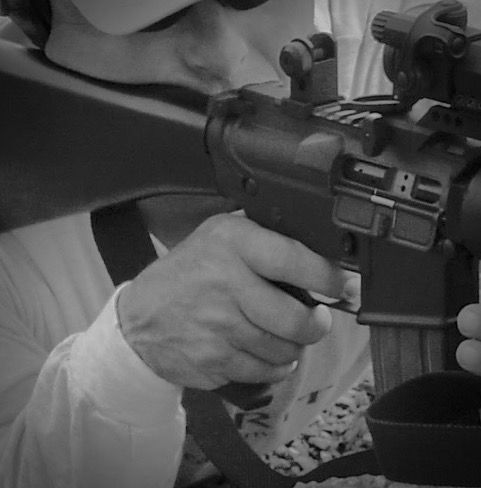 |
The fundamentals of firing an accurate shot are Aim, Hold, Press and Follow Through. You aim by getting the sights in alignment between your eyes and target. Visually, you hold by watching, seeing or looking at the front sight. Applying smooth pressure to the trigger – press – fires the shot. Follow through consists of recovering from the recoil, reacquiring a sight picture and resetting the trigger, releasing it far enough for the internals to reset but not letting all the slack or take-up out of the trigger or finger losing contact with the trigger. The most difficult part is manipulation of the trigger.
Very little of our natural instincts apply to using a firearm efficiently. We’re not designed to have explosions going off in our hand, even controlled detonation. As the trigger is pressed, we often will pull or push it to one side or the other. When force is applied against us – recoil - it’s natural to resist with an equal or more aggressive action. Add all this up, and it makes it difficult to fire the weapon without anticipating the coming “bang” and recoil, which of course causes us to jerk the sights off target right before the shot fires.
Pressure applied to the trigger must be smooth, from start to finish, straight to the rear – no pushing/pulling - and without anticipating the recoil. It all starts by acquiring the proper grip on your weapon; firearm fit is mandatory. The correct size weapon will allow you to form an “L” shape with the trigger finger. Movement of the finger occurs in the middle joint. The pad of the finger touches the trigger so its pad is centered on the trigger. This allows you to feel what’s occurring as pressure is applied. Then, imagine there’s a glass rod running from the trigger straight back to your nose, and press to the rear without bowing, pushing or pulling the rod. Straight to the rear.
A smooth “press” is mandatory. It must be constant pressure all the way through the shot, without speeding up or slowing down. (Keep in mind taking the slack out of the trigger isn’t part of the press. Remove the take-up, then the press begins.). And you have to press without anticipating when the shot is going to fire. In the beginning, this takes complete and total concentration. This means you have to occupy the mind with pressing the trigger, and only pressing the trigger.
There are several techniques I use with students, both new and experienced, to obtain the proper press. Once the shooter is on target, and on the trigger – slack or take-up removed – I have them say out loud, “presssssssss…,” or have them count, “1, 2, 3, 4, … .” At the same time they steadily increase pressure on the trigger.
The goal is achieving a “surprised break.” When the shot fires it should be a complete surprise. If not, you’re going to tense up muscles in anticipation of the recoil. Linking the physical press with verbalization accomplishes two things. It focuses the conscious mind - which can only think about one thing at a time - on the “press,” and slows the mind down, otherwise it will get way ahead of the physical. Having the student say it out loud also lets me tell what they’re thinking as they perform the press. If the shot keeps breaking at the same time it lets me know they’re making the weapon fire, as opposed to letting it fire.
This technique – verbalization – works like magic. The key is you have to say it out loud. Just thinking it in your mind doesn’t work well, especially in the beginning. Someday, with practice, you can just think it. Some claim to not even have to think about the press, but for the rest of us, the more practice the better.
(Next week, Trigger Manipulation Pt. II – Follow Through.)
Tiger McKee is director of Shootrite Firearms Academy, which is celebrating its twenty-fifth anniversary. He is the author of The Book of Two Guns, AR-15 Skills and Drills, has a regular column in American Handgunner and makes some cool knives and custom revolvers. Visit Shootrite’s Facebook page for other details.